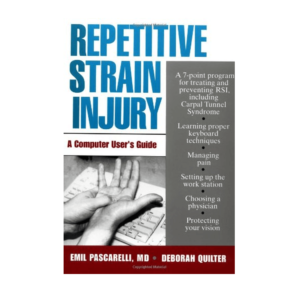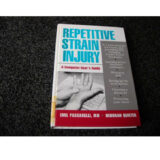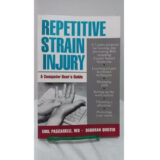(Last Updated on November 4, 2025 by Henry)
- Name: “RSI: A Computer User’s Guide”
- Type: Rehab Manual
- Rating: 4.6 out of 5 stars
- Availability: Amazon
- Learn how to prevent both RSI & Carpal Tunnel syndrome
- Hundreds of easy-to-read explanations with illustrations & practical suggestions
- Helps you to set up your workstation properly
Repetitive Strain Injury: A Computer User’s Guide
By E.Pascarelli, M.D. & D.Quilter; Publisher: Wiley (February 15, 1994)
What Can You Learn From “Repetitive Strain Injury: A Computer User’s Guide”?
A Bible For Those Who Suffer From RSI:
“A wealth of information for people who have Repetitive Strain Injury, for those who want to prevent it, and especially for those who think it doesn’t concern them.
Every computer user has the potential for repetitive strain injury and should heed the advice in this book.” Caroline Rose, Editor, The RSI Network
“This is the most useful book I have seen for RSI sufferers. It is refreshing to read a book that takes these injuries seriously and offers sound advice.” Robert Dieterich, Managing Editor, VDT News.
“Easy to read, expertly illustrated, and filled with hundreds of commonsense explanations and practical suggestions for those suffering from all types of repetitive strain injuries. Particularly outstanding is Dr. Pascarelli’s sensitivity to the impact of emotional distress and fear on physical well-being and recovery.” Stewart Leavitt, PhD, Office of Ergonomics Researchers, Leavitt Medical Communications.
The great speed, ease, and efficiency of personal computers can lead to severe physical and emotional pain. The problem is called “Repetitive Strain Injury,” or RSI, and includes a wide range of conditions, from Carpal Tunnel Syndrome to Tenosynovitis.
Over time, this “epidemic of the ’90s” damages the muscles, nerves, and tendons of the hands, wrists, and arms. Dr. Pascarelli’s seven-point plan offers proven ways of preventing the onset of RSI as well as tested methods that will help RSI sufferers to once again lead healthy, productive, and pain-free lives.
This book has become a bible for those suffering from RSI. It explains what to ask your doctor (and why) when you go in for a diagnosis; it also lists more than two dozen types of RSI and related conditions, from cervical radiculopathy to reflex sympathetic dysfunction to fibromyalgia. If these terms sound intimidating, then the book succeeds in bringing them down to clear, manageable definitions.
Quilter and Pascarelli also delineate the causes of RSI that are often unconsidered, including being obese, typing while cradling the phone with your shoulder, and having long fingernails.
They don’t discuss many of the different surgeries used for RSI, but instead choose to discuss the various kinds of physical and occupational therapy treatments, acupuncture, stretching, vitamins and nutrition, relaxation techniques, deep tissue massage, and guided visualization.
There’s also an extensive list of helpful tricks for adapting to living with RSI, from making changes in the kitchen to re-learning how to drive.
This is also the RSI book if you’re looking for information on the psychological ramifications of RSI and how to handle both time off from work and the return to the office.
About the Author of Repetitive Strain Injury
Emil F. Pascarelli, M.D., one of the world’s leading experts on repetitive strain injury, is an Attending Physician at Columbia-Presbyterian Medical Center, practices as a consultant in cumulative trauma disorders at Columbia-Presbyterian Eastside, and is Director of Ambulatory Care at St. Luke’s/Roosevelt Hospital in New York City.
He is also the founder and Medical Director of the Miller Institute for Performing Artists, Professor of Clinical Medicine at the College of Physicians and Surgeons of Columbia University, and Associate Professor of Clinical Public Health at New York Hospital-Cornell Medical Center.
Deborah Quilter is a veteran health writer who has contributed to the Columbia Journalism Review, The New York Daily News, Woman’s World, and San Francisco Focus, among others.
Book Details
- Publisher: Wiley (February 1994)
- Language : English
- Paperback: 240 pages
- Dimensions : 15.5 x 1.58 x 22.95 cm
Thanks for Stopping By
Have Questions?
Please Leave A Comment









I am trying to help my wife out because she is always complaining about pain in her wrist. I appreciate all the information you have presented here. Crazy, life seems to keep pushing me towards Emil F. Pascarelli and this book.
I definitely need to be looking in to it, it seems… I really hope she doesn’t get to the point of needing to relearn anything like how to drive. I never thought about the psychology… no wonder she seems more stressed and short-tempered.
Do you have any advice how to help her cope with this or is it all just in the book?
Thanks again,
G.Mack
R.I.C.E. – rest, ice, compression, elevation is a recommended first-aid regimen for soft tissue injuries. Sorry to hear she’s in pain.
Could be as tiny detail as swapping out mousepad on your computer setup, overall posture. Curiously in female case the use of long fingernails for example, or the way she is used to tap smartphone screen.
All highly relevant in our everyday activities. That’s the essence of RSI, we seek to break the pattern that feeds it.
To find it, first order of the business I’d say is to gain insight & diagnose to understand what’s going on. It’s likely, that at some point while reading comprehensive self-treatment manuals you come across paragraph describing your situation. Then you know you’ve nailed it.
Keep in mind, methods of recovery can largery differ depending on if it’s acute injury or progressed to chronic condition state.